Convert Bank Statements to Excel
Easily convert bank statements to Excel with accurate data extraction. Transform PDFs into structured Excel or CSV files for seamless financial tracking.
Add Your File
Drag & Drop Or Select File
Data security is our top priority
Bank Statement Converters prioritises the confidentiality and integrity of your data. As a testament to our commitment, we adhere to stringent compliance standards, including GDPR, SOC 2, and HIPAA. Privacy Policy



How to Convert Your Bank Statement To Excel
Why Choose Convert Bank Statements to Excel?
Accessibility
Our platform is built for easy access—mobile, desktop, or assistive tools. Quickly convert PDF bank statements to Excel spreadsheets without complex steps.
Affordable Plans for Everyone
Affordable Plans for Everyone tailored to meet diverse needs without breaking the bank, offering flexibility and value for all.
Starter
$90 / month
Save 10% annually
Why should you take this
4,800 pages per year
PDF Bank Statement to Excel
PDF Bank Statement to CSV
Convert Password Protected Statement
Multiple PDFs to a Single CSV
Global Banks Supported
Get Started
Professional
$180 / month
Save 20% annually
Why should you take this
12,000 pages per year
PDF Bank Statement to Excel
PDF Bank Statement to CSV
Convert Password Protected Statement
Multiple PDFs to a Single CSV
Global Banks Supported
Get Started
Business
$360 / month
Save 20% annually
Why should you take this
48,000 pages per year
PDF Bank Statement to Excel
PDF Bank Statement to CSV
Convert Password Protected Statement
Multiple PDFs to a Single CSV
Global Banks Supported
Get Started
Most Popular
Enterprise
$Custom / month
Save 20% annually
Why should you take this
PDF Bank Statement to Excel
PDF Bank Statement to CSV
Convert Password-Protected Statement
Multiple PDFs to a Single CSV
Global Banks Supported
Get Started
Bank Statement to Excel Converter or OCR Software: Which One Delivers Cleaner Data?
Features
Bank Statement to Excel Converter
Traditional OCR Software
Keeps table structure
Supports scanned and native PDFs
Fixes broken rows and merged cells
Excel ready formatting (dates, currency)
Works with QuickBooks/Xero templates
Supports password protected PDFs
Manual review for accuracy
Output works across Excel & Google Sheets
No extra formatting needed after export
Export to clean CSV as well
Frequently Asked Questions
Will my data remain secure when using an online bank statement converter?
Can I convert multiple bank statements at once?
How do I clean up and format bank statement data in Excel?
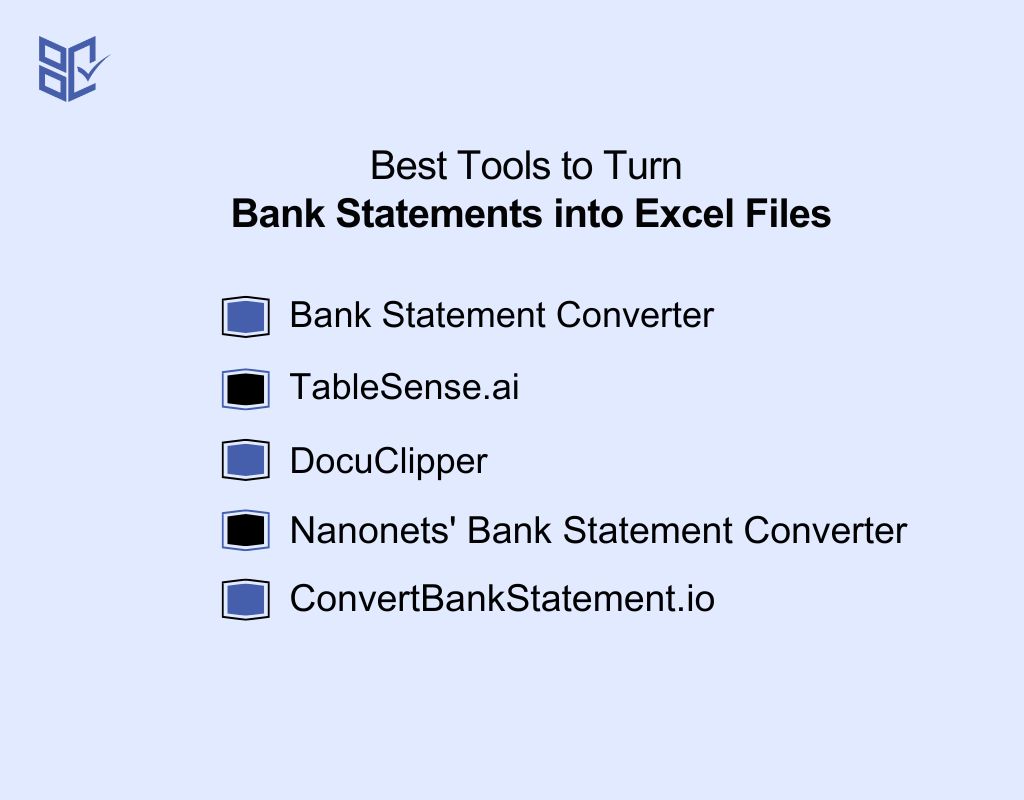
Managing your finances effectively often requires analyzing your bank statements. By converting bank statements to Excel, you can easily sort, filter, and perform calculations on your financial data. This process is beneficial for tasks like financial analysis, record-keeping, tax preparation, and expense tracking.
Instead of manually entering data, which can be time-consuming and error-prone, you can use various tools and methods to quickly convert bank statements to Excel. This approach not only saves time but also enhances the accuracy of your financial records.
Here, you’ll discover efficient ways to convert bank statements to Excel, ensuring seamless financial management and better data organization.
What Is an Excel Bank Statement?
An Excel bank statement is a spreadsheet version of your bank statement, converted from PDF or other formats. It allows you to sort, filter, and analyze financial transactions efficiently. With Excel, you can track expenses, prepare reports, and manage finances more accurately without manual entry.
Bank statement in Excel is a structured spreadsheet that contains all your financial transactions, including deposits, withdrawals, and balances.
When you convert PDF bank statements to excel, you can organize data into columns and rows, making it easier to track your income and expenses. This format is widely used for bookkeeping, tax preparation, and financial analysis.
By having your bank statement in Excel, you can perform calculations, generate reports, and even integrate the data into accounting software. It eliminates the hassle of manually recording transactions and reduces errors.
Whether you’re a business owner, accountant, or individual, using an Excel bank statement helps you stay on top of your financial records.
Why Should You Turn Bank Statements into Excel Files?
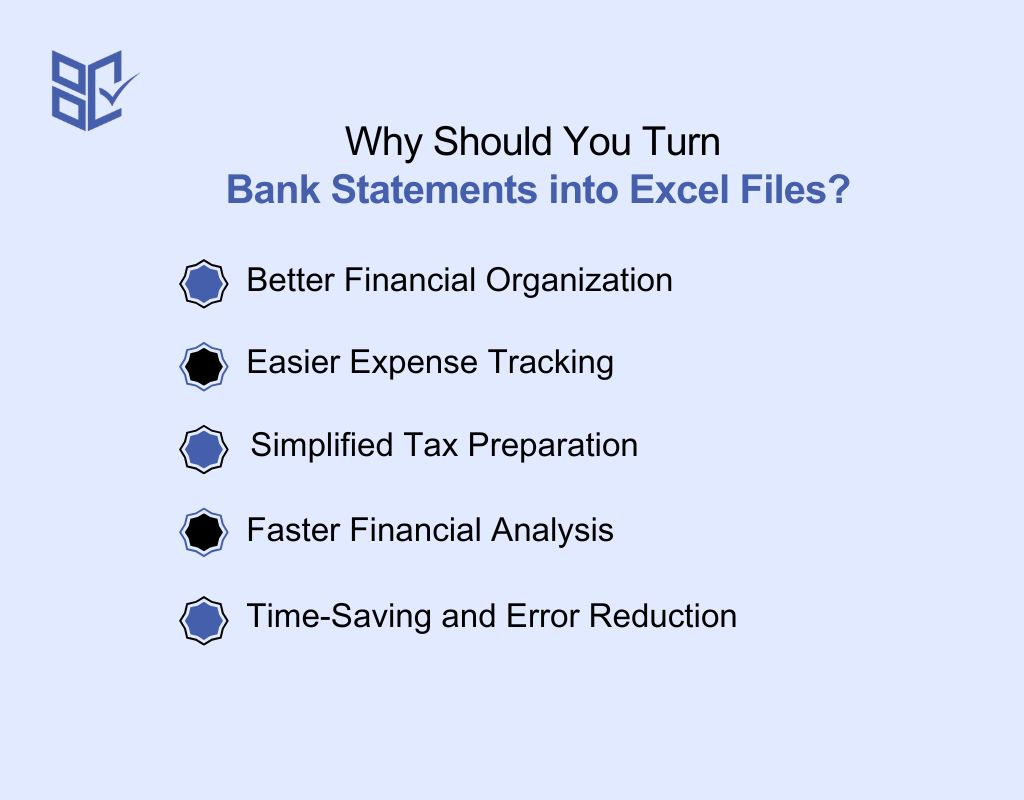
Managing financial data is easier when it’s well-organized. Converting bank statements to Excel helps you analyze transactions, track expenses, and prepare financial reports efficiently. Here are key reasons why this conversion is beneficial for you:
Better Financial Organization
When you convert bank statements to Excel, you can neatly arrange transactions in rows and columns. This makes it easy to categorize expenses, track payments, and monitor balances. Instead of scrolling through PDFs, you can quickly search for specific transactions and organize data based on dates, categories, or amounts.
Easier Expense Tracking
Keeping track of expenses is essential for personal and business finances. Excel allows you to filter and sort transactions, making it simple to identify spending patterns. With formulas and charts, you can calculate monthly expenses, compare spending trends, and make informed financial decisions without manually adding up amounts.
Simplified Tax Preparation
Filing taxes requires accurate financial records. When your bank statement is in Excel, you can easily extract income and expense details. This helps in preparing tax documents, ensuring you don’t miss deductible expenses. Plus, accountants can process Excel files faster, reducing the time and effort spent on tax filing.
Faster Financial Analysis
Excel provides tools like pivot tables, charts, and formulas to analyze financial data efficiently. You can compare income versus expenses, identify cash flow trends, and generate financial summaries. Instead of manually reviewing statements, Excel lets you process large volumes of data quickly, improving financial decision-making.
Time-Saving and Error Reduction
Manual data entry from PDFs is time-consuming and prone to mistakes. When you convert bank statements to Excel, you eliminate typing errors and save hours of work. Automated conversion tools extract transaction details accurately, reducing the risk of miscalculations and ensuring financial records remain precise and up to date.
Easy Way to Convert a Bank Statement to Excel
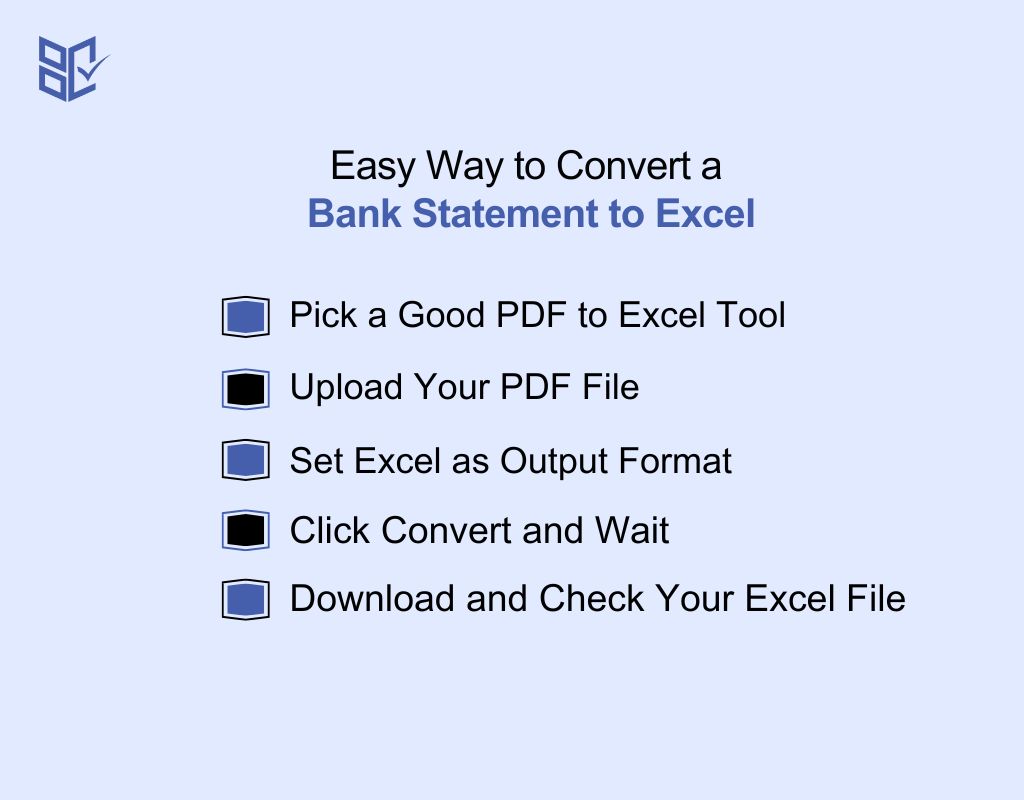
If your bank statement is in PDF, it’s hard to work with. Turning it into Excel lets you sort, filter, and analyze your money easily. Here’s how to convert bank statements to Excel online:
Pick a Good PDF to Excel Tool
Pick a converter that supports bank statements. A reliable converter detects tables and keeps your data in the right format. Look for security and accuracy. Avoid tools that break rows or give poor layouts. A good tool makes the whole process smooth and fast.
Upload Your PDF File
Click the upload button and select your bank statement PDF. Some tools support drag-and-drop. Make sure your file is not locked or scanned too poorly. Clear, text-based PDFs give better results. Once uploaded, the tool reads the file and prepares it for conversion. You’ll see a preview in some tools.
Set Excel as Output Format
Before converting, choose Excel or XLSX as the output format. Some tools let you select settings like table detection or clean formatting. Choosing the right format helps avoid messy layouts. This step is key for getting a usable spreadsheet. Stick to Excel unless you need a CSV file.
Click Convert and Wait
Hit the convert button and let the tool work. It reads your PDF and builds the Excel file. Most tools take just a few seconds. Don’t refresh or close the page. After the conversion, a download link or button appears. You’re now ready to download your Excel bank statement.
Download and Check Your Excel File
Download the converted file and open it in Excel or Google Sheets. Review the rows and columns. Check for missing entries, misaligned cells, or bank statement to Excel formatting issues. If everything looks right, save the file. You can now filter, sort, or use it for tax, budgeting, or bookkeeping tasks.
Who Finds Bank Statements Easier to Use in Excel?

Whether you’re an individual, business owner, or financial professional, having bank data in Excel makes financial tasks easier. Here are groups of people who benefit from it:
Business Owners and Entrepreneurs
If you run a business, keeping track of income and expenses is important. A bank statement Excel helps you monitor cash flow, manage invoices, and track payments. It also simplifies financial reporting, making it easier to plan budgets and assess profitability.
Accountants and Bookkeepers
Accountants and bookkeepers rely on bank statement Excel files for accurate financial reporting. It helps in reconciling bank accounts, preparing financial statements, and maintaining organized records. Excel’s features, like Pivot Tables and Formulas, allow professionals to analyze data quickly and efficiently.
Freelancers and Self-Employed Professionals
Freelancers often deal with multiple income sources and client payments. Having bank transactions in Excel makes it easier to track earnings, calculate taxes, and manage invoices. It also helps freelancers understand their cash flow and plan expenses accordingly.
Individuals Managing Personal Finances
If you want to track your income, spending, and savings, converting your bank statement into Excel can help. You can categorize expenses, monitor monthly spending, and plan budgets efficiently. Excel also allows you to create charts and summaries for better financial planning.
Tax Consultants and Financial Advisors
Tax professionals and financial advisors use bank statement Excel files to analyze clients' financial records. It helps in calculating tax deductions, filing tax returns, and providing financial advice. Having transaction data in a structured format makes tax preparation and financial planning smoother.
Common Errors in Bank Statement to Excel Conversion and How to Solve Them
Converting bank statements to Excel can sometimes lead to errors, misaligned data, or missing transactions. These issues can impact financial accuracy. Here is a table highlighting common problems, their causes, and solutions:
Issues | Causes | Solutions |
Incorrect Data Formatting | Bank statements have different structures that don’t align properly in Excel. | Use Text to Columns or Power Query in Excel to restructure the data. |
Mismatched Columns and Rows | Data gets misaligned due to inconsistent formatting in the source file. | Check the source file and adjust column widths manually or use alignment tools. |
Missing Transactions | Some transactions might be skipped due to incorrect extraction methods. | Verify extraction settings and compare the original file with the converted data. |
Special Characters and Symbols | Special symbols like $, €, or commas may cause errors in calculations. | Use Find and Replace or Excel functions to remove or format symbols properly. |
Duplicate Entries | Duplicate transactions appear due to data extraction issues. | Apply Remove Duplicates under the Data tab in Excel. |
Date Format Errors | Different date formats lead to sorting and calculation problems. | Change the date format in Format Cells and ensure uniform date settings. |
Key Features of a Good Bank Statement to Excel Converter
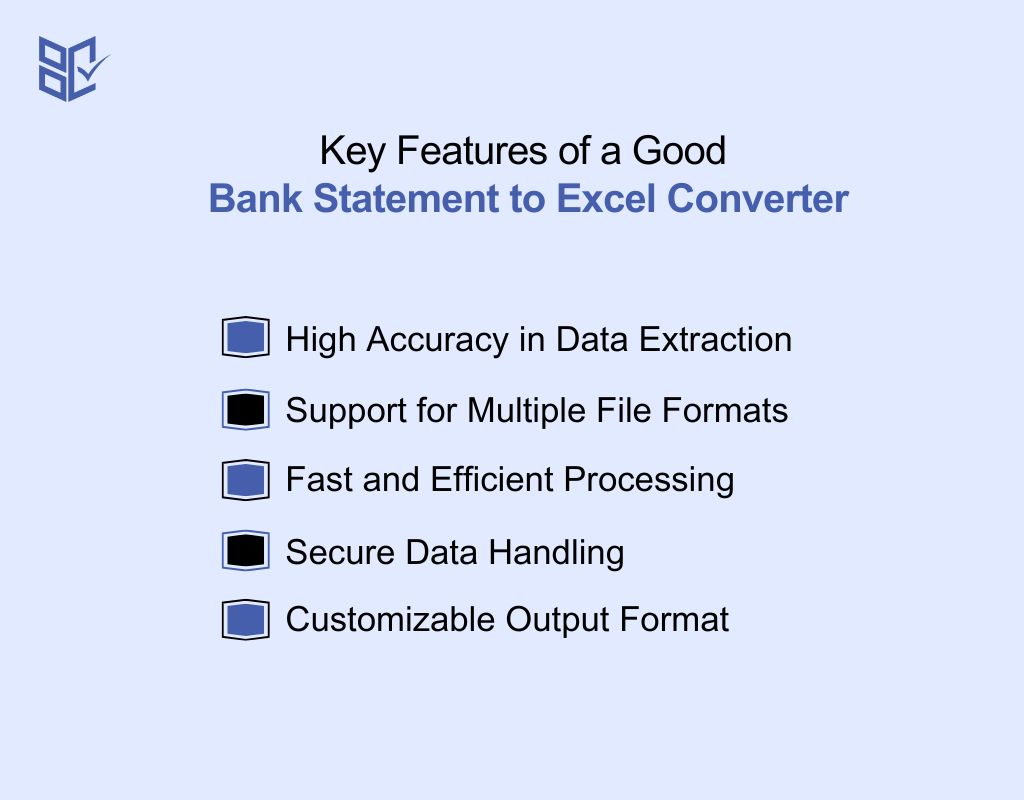
A good bank statement to Excel converter should be accurate, fast, and easy to use. It should simplify financial data extraction while ensuring security and flexibility. Here are key features to look for when choosing a bank statement converter:
High Accuracy in Data Extraction
A good converter should extract all transactions, amounts, and dates accurately without missing or misplacing data. It should maintain the original structure and format of your bank statement, ensuring that your financial records stay reliable and error-free.
Support for Multiple File Formats
Bank statements come in PDF, CSV, TXT, and even scanned formats. A great converter should support multiple formats and allow seamless conversion into Excel, CSV, or accounting software-friendly files. This flexibility makes it useful for different financial management needs.
Fast and Efficient Processing
Time is valuable, especially for businesses and accountants. A fast converter processes large volumes of transactions in seconds. It should also handle multiple bank statement files at once, making financial data management much quicker and hassle-free.
Secure Data Handling
Since bank statements contain sensitive financial information, security is essential. A good converter should use encryption and secure processing methods to protect your data. If using an online tool, ensure it doesn’t store or share your financial records.
Customizable Output Format
Different users need different data formats. A high-quality converter should allow you to customize column headers, remove unnecessary data, and format numbers properly. This feature ensures that your converted bank statement matches your preferred structure for analysis or accounting software integration.
How Do Bank Statements to Excel Tools Work?
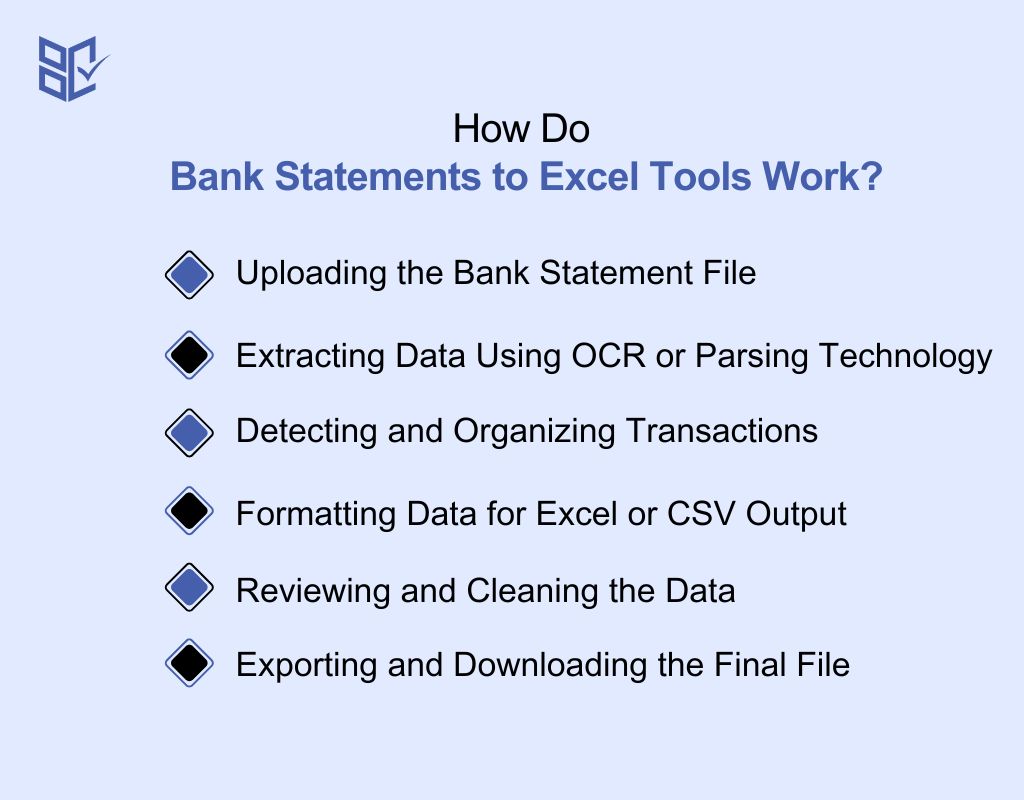
A bank statement converter helps you transform your PDF, scanned, or other file formats into Excel. This makes it easier to organize, analyze, and use financial data. Here’s how these tools work:
Uploading the Bank Statement File
You start by uploading your bank statement into the converter. It can be in PDF, scanned image, or text format. Some tools allow drag-and-drop features, making the process quick and effortless.
Extracting Data Using OCR or Parsing Technology
The converter reads and extracts transaction details from the statement. If it’s a digital PDF, parsing technology identifies structured data. For scanned files, Optical Character Recognition (OCR) detects text and numbers accurately.
Detecting and Organizing Transactions
Once the data is extracted, the converter identifies columns like date, description, amount, and balance. It then arranges them in an easy-to-read format. Some tools allow customization, so you can adjust fields as needed.
Formatting Data for Excel or CSV Output
After organizing the transactions, the tool converts the extracted data into Excel format. It ensures numbers, dates, and currency symbols are formatted correctly for accurate calculations and analysis.
Reviewing and Cleaning the Data
Some converters offer built-in cleaning tools to fix misaligned data, remove duplicates, and correct formatting errors. This step ensures that your financial records are accurate, structured, and ready for use.
Exporting and Downloading the Final File
Once everything looks good, you can export the file and download it in Excel format. Some tools also allow direct integration with accounting software like QuickBooks or Xero for seamless bookkeeping.
Best Tools to Turn Bank Statements into Excel Files

Converting bank statements to Excel helps streamline financial data management. Here is a detailed look at the top bank statement converters, highlighting their features, benefits, and usability.
Bank Statement Converter
This tool supports thousands of banks worldwide, offering quick and accurate PDF-to-Excel conversion. It maintains the original structure of bank statements, ensuring clean and error-free financial records. Ideal for businesses, accountants, and individuals who need organized transaction data for financial analysis.
TableSense.ai
A powerful AI-driven tool, TableSense.ai accurately extracts transaction details from PDF bank statements and converts them into Excel, CSV, or JSON formats. It’s built for speed and supports bulk processing, making it perfect for businesses handling large volumes of financial data.
DocuClipper
A well-known tool for converting PDF bank statements into Excel or CSV with precision. It’s particularly useful for accounting professionals and tax preparers who require structured financial data for audits, bookkeeping, and compliance reporting. It integrates seamlessly with QuickBooks and other accounting software.
Nanonets' Bank Statement Converter
A completely free tool that allows users to convert up to 500 pages of bank statements into Excel or CSV without registration. It uses advanced AI and OCR to extract data accurately, making it a great choice for those working with scanned PDFs or images.
ConvertBankStatement.io
This platform offers highly accurate conversion of bank statements from over 1,000 financial institutions worldwide. Users can convert PDFs into Excel or CSV with a few clicks. Its secure data handling and batch processing make it an efficient choice for accountants and businesses.
Conclusion
Converting bank statements to Excel simplifies financial tracking, analysis, and reporting. Whether you are managing personal finances or handling business bank accounts, having your transaction data in Excel makes it easier to organize, filter, and analyze.
To ensure accuracy, always review the converted data for errors or missing transactions. Use trusted converters that support multiple formats and maintain data integrity. For security, avoid online tools that store your data and always keep backups.
By following these steps, you can convert bank statements to Excel seamlessly, making financial management more efficient, accurate, and secure.